|
Unsheathing Antique Swords
by
Bob Brooke
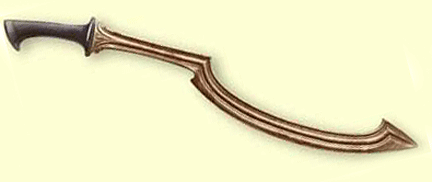 Swords
have been in existence from as far back as 3,700 BCE, when copper mining
began in ancient Egypt and Anatola (what’s now Turkey) to the present
day. However, soldiers only used them in battle until the end of the
19th century. Today, they’re mostly used as presentation accessories. Swords
have been in existence from as far back as 3,700 BCE, when copper mining
began in ancient Egypt and Anatola (what’s now Turkey) to the present
day. However, soldiers only used them in battle until the end of the
19th century. Today, they’re mostly used as presentation accessories.
Most people know little about antique swords or their history. Swords
have evolved over many centuries, with parts added and improvements made
in handling, sharpness, and length.

There are two main parts of a sword: the blade and the hilt. Everyone
knows what and where the blade is on a sword. Blades have basic parts
like the point (at the end), edge, and fuller. A fuller is an
indentation or groove that runs partial or the entire length of the
blade. The fuller allows the blood to run out of the body of the enemy
once the blade is inserted into the enemy’s body. A sword may have a
single or a double fuller depending on its type.
The Blade
Made with a single or double-edge and used to cut, thrust or both, the
blade has several parts. The edge, the sharpened portion of blade used
for slashing; the tip, the sharp end that usually tapers to a point; and
the back, the part opposite the edge. There’s also the sides of the
blade, known as the flat, and the fuller, the groove running along a
sword’s length to decrease weight without reducing strength. In battle,
the fuller allows the victim’s blood to pour out of the wound, making it
more deadly.

The Hilt
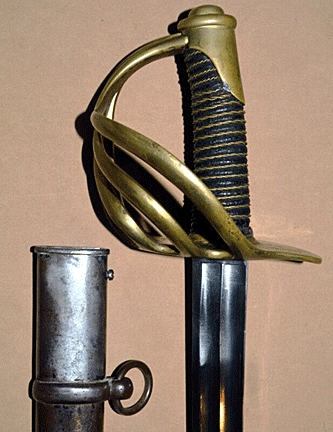 Besides
a blade, swords also have a hilt, the area of the sword where the user’s
hand rests and grips the sword. Parts of the hilt include the pommel,
located at the end of the sword, cross guard which protects the hand,
and grip, where the user’s hand grips the sword beneath the cross guard.
All of these parts were usually made of leather, wood, or wire. Besides
a blade, swords also have a hilt, the area of the sword where the user’s
hand rests and grips the sword. Parts of the hilt include the pommel,
located at the end of the sword, cross guard which protects the hand,
and grip, where the user’s hand grips the sword beneath the cross guard.
All of these parts were usually made of leather, wood, or wire.
The hilt also has several parts. The tang, the hidden portion of the
blade covered by the hilt, which varies in thickness and width, and
usually runs through to the pommel. The pommel, the end of the sword
located at the hilt, which acts as a counterweight and prevents a sword
from sliding out of the user’s hand. And the guard, a metal piece
preventing an opponent from cutting off your hand, while also helping
with point control and blade movement.
Types of Swords
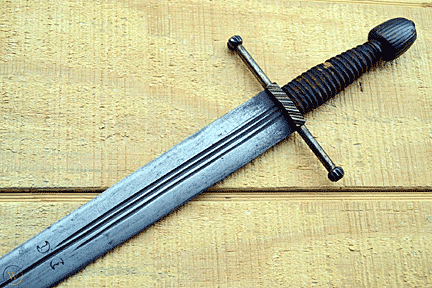 Some
common swords are the straight backsword, a military sword with a rigid
blade and basket hilt, or broadsword, a military sword with a double
edged blade and basket hilt. There’s also the curved saber, a long,
curved single edged blade used by cavalry soldiers. Some
common swords are the straight backsword, a military sword with a rigid
blade and basket hilt, or broadsword, a military sword with a double
edged blade and basket hilt. There’s also the curved saber, a long,
curved single edged blade used by cavalry soldiers.
There are nine swords on which most collectors focus. The Falchion was a
heavy, short, single-edged blade used from the 13th to 15th Century,
mainly by European knights. The Longsword was a two-edged blade,
measuring up to 50 inches, produced by German and Swiss blacksmiths for
thrusting, cutting and close contact battles during the 15th and 16th
Century.
The Greatsword was a large, two-handed sword with up to a 72-inch blade
used for close contact fighting in the 16th and 17th Century. It had up
to a 21-inch handle and weighed up to 10 pounds. From the 17th to the
19th Century, soldiers wielded a double-edged military sword called a
Broadsword, measuring up to 45 inches, which they used for slicing and
cutting off limbs.
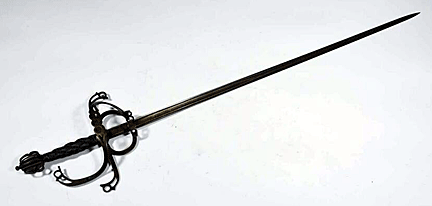 From
the 16th to the 17th Century, military officers used a lightweight,
double-edged blade with a thick cross section, called a Rapier, to
fence, thrust, and duel. It is also known as the Rapier after
modifications made to the hilt in the 17th Century. From the 19th
Century, it became known as a Gentleman's or walking sword, used to
signify military rank or an officer’s class. From
the 16th to the 17th Century, military officers used a lightweight,
double-edged blade with a thick cross section, called a Rapier, to
fence, thrust, and duel. It is also known as the Rapier after
modifications made to the hilt in the 17th Century. From the 19th
Century, it became known as a Gentleman's or walking sword, used to
signify military rank or an officer’s class.
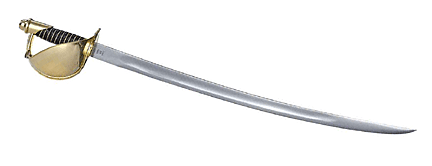 Navel
officers and sailors used a standard sword, called a Cutlass, made in
various styles, in naval conflicts. Navel
officers and sailors used a standard sword, called a Cutlass, made in
various styles, in naval conflicts.
Made for battle in the 19th to the early 20th Century, the Calvary Saber
had a curved blade was used prominently in the Napoleonic Wars, U.S.
Civil War, World War I and World War II.
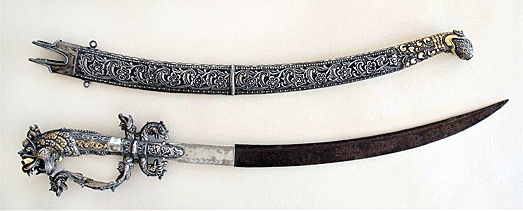
People often use the words "sword" and
"saber" interchangeably, but the blades differed in both design and
purpose. Swords tend to be straight, and often have sharpened edges on
two sides while Sabers had curved blades with convex, or outside, edges
were meant for slashing.
And lastly, Artillery Swords, issued to sergeants and musicians of
infantry regiments was a shorter sword, with a straight, double-edged,
25-inch blade and brass-mounted leather scabbard.

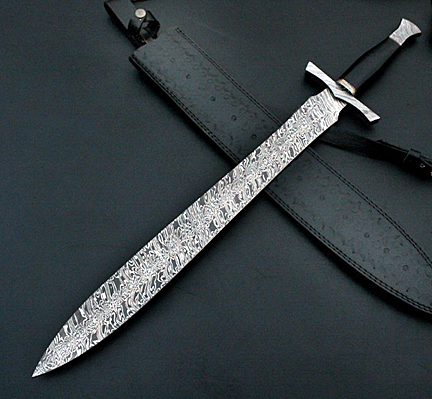 Blacksmiths
constructed the best swords from hardened steel. One such type of steel,
known as Damascus steel, created a blade forged from laminated layers of
metal that were stacked, folded when heated, or both. Sometimes these
blades had 100 layers, plus an extra-hard layer of a wootz in the center
so that the part of the sword that was sharpened to a lethal edge was
also tough enough to withstand repeated blows. A common characteristic
of Damascus steel was the mottling on its surface, the evidence of all
those layers that appeared as leopard spots, wood grain, or moiré
patterns when the blade was polished. Blacksmiths
constructed the best swords from hardened steel. One such type of steel,
known as Damascus steel, created a blade forged from laminated layers of
metal that were stacked, folded when heated, or both. Sometimes these
blades had 100 layers, plus an extra-hard layer of a wootz in the center
so that the part of the sword that was sharpened to a lethal edge was
also tough enough to withstand repeated blows. A common characteristic
of Damascus steel was the mottling on its surface, the evidence of all
those layers that appeared as leopard spots, wood grain, or moiré
patterns when the blade was polished.
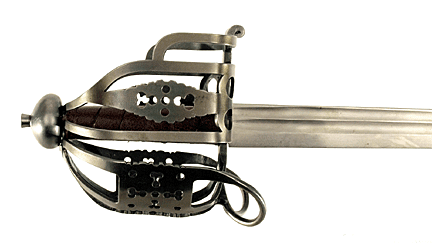 Beyond
the blades, swords also had guards and metal coverings, sometimes called
baskets, that protect a hand gripping a sword's hilt or handle. At the
end of the hilt is the pommel, which is usually wider than the hilt to
keep the sword from slipping out of a user's hand—pommels can also be
used as a weapon when fighting at close range. Beyond
the blades, swords also had guards and metal coverings, sometimes called
baskets, that protect a hand gripping a sword's hilt or handle. At the
end of the hilt is the pommel, which is usually wider than the hilt to
keep the sword from slipping out of a user's hand—pommels can also be
used as a weapon when fighting at close range.
Over the years, sword makers added other design features to signify
military rank, social class and the sword or fighter’s country of
origin.
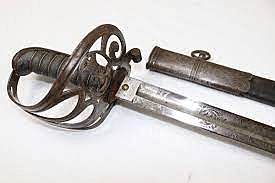 Users
wore a sword belt to carry their swords. To protect themselves from
being cut from the blades, swords had a protective sheath, called a
scabbard, made from leather, steel, brass, or wood. A piece of
decorative woven material, called a tassle, wrapped around the user’s
hand, prevented them from dropping the sword. Users
wore a sword belt to carry their swords. To protect themselves from
being cut from the blades, swords had a protective sheath, called a
scabbard, made from leather, steel, brass, or wood. A piece of
decorative woven material, called a tassle, wrapped around the user’s
hand, prevented them from dropping the sword.
Sometimes a sword comes with distinguishing hallmarks, a signature or
maker's mark which can help to identify where it was manufactured and by
whom.
The historical significance of a sword can cause its value to increase,
especially if it was previously owned by a historical figure or was used
in significant battle. All types of swords often command high values on
the open market, some upwards of $50,000 or more. Even some
reproductions attract buyers with deep pockets.
<
Back to Antiques Archives
Next Article > |
